Menus
- Refinement and Precision
- Legs are stowed away more comfortably
- Slides on the rear wheel are easy to control
- Honda CBR 1000 RR Fireblade SP happily lifts the front wheel
- That is new?
- facts and figures
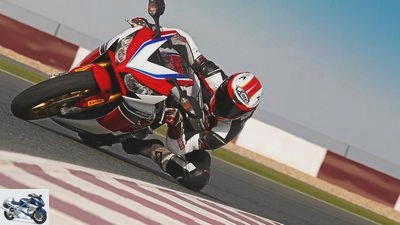
Honda
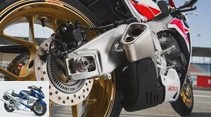
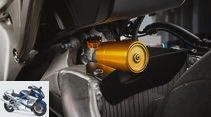

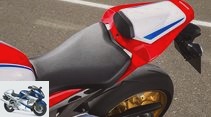
22nd photos
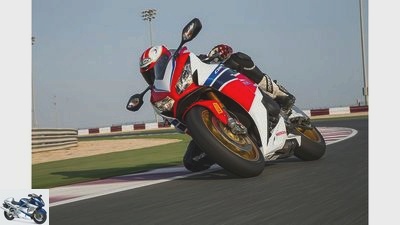
Honda
1/22
From the outside, there is hardly anything to suggest that Honda’s top athletes for 2014 have experienced more than just visual retouching.
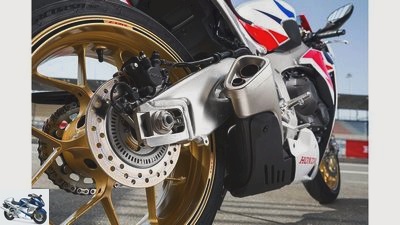
Honda
2/22
The Combined ABS can still not be switched off, but for the SP it is more geared towards sports use. Stepping on the rear brake no longer activates the front brake as strongly.
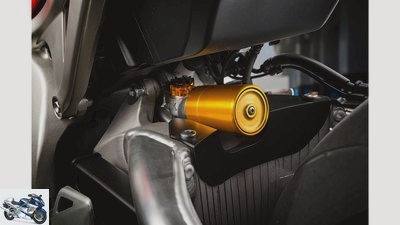
Honda
3/22
Easily accessible damping adjustment screws and 8 mm screw for spring preload.
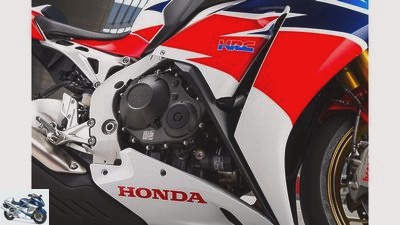
Honda
4/22
The water-cooled four-cylinder four-stroke in-line engine of the Honda CBR 1000 RR Fireblade SP.
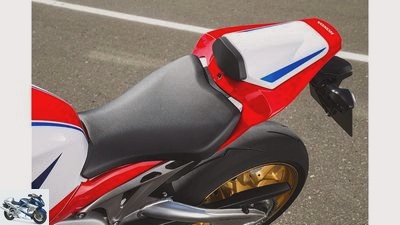
Honda
5/22
The narrow seat of the Honda Fireblade SP.
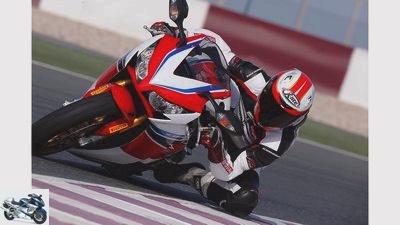
Honda
6/22
It is questionable whether it was the right decision to let the Blade start without these driving aids. At least the slides on the rear wheel can be easily controlled thanks to the great feedback and finely adjustable throttle.
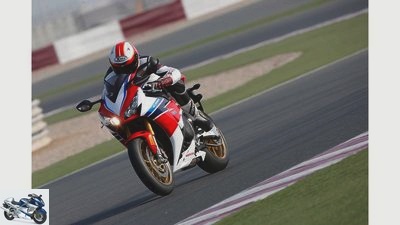
Honda
7/22
Linear power development, great controllable power are the basis for fast lap times.
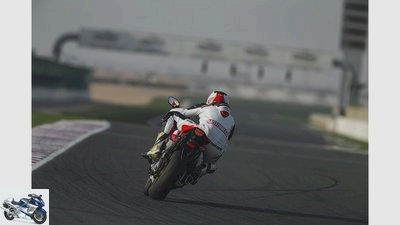
Honda
8/22
At the end of the approximately one kilometer long home straight, the Blade rushes into the braking zone with around 285 on the speedometer.
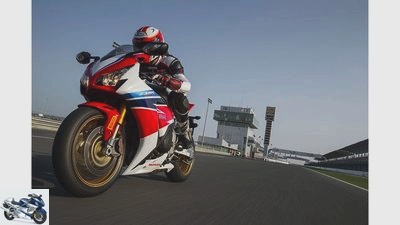
Honda
9/22
Not only a lot of performance makes you fast, but also the possibility of using the performance early on.

Honda
10/22
Incidentally, the new windshield offers decent wind protection.
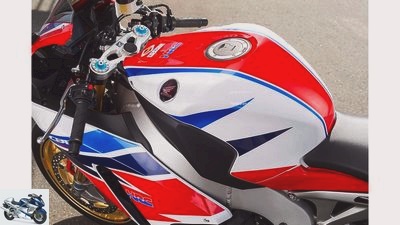
Honda
11/22
The tank has a total of 17.5 liters.
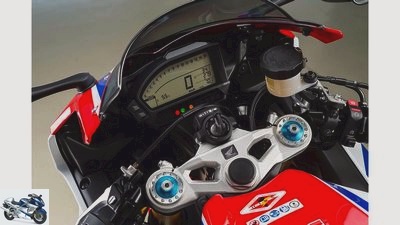
Honda
12/22
CNC-machined upper triple clamp with larger clamping area on the bars for more rigidity.
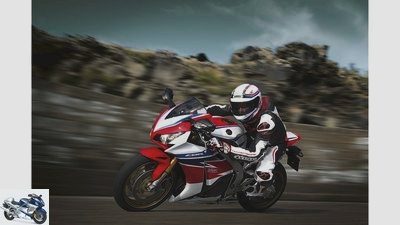
Honda
13/22
But you can already tell when you sit down that a little more has happened.
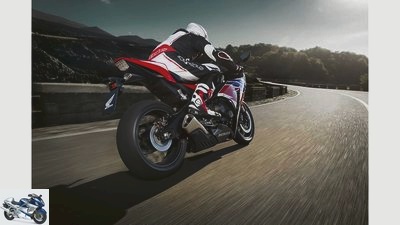
Honda
14/22
Changes to the chassis and engine help both the standard and the SP version and the blade achieve an increase in output of 3 to 181 hp.
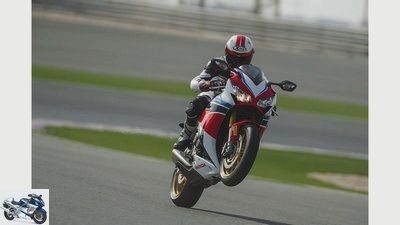
Honda
15/22
The SP also rolls on sporty Pirelli SP rubbers.
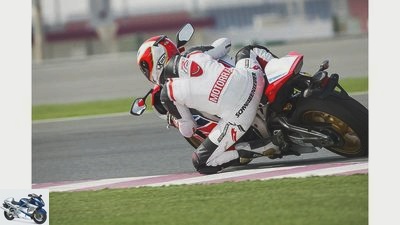
Honda
16/22
The revised sitting posture quickly proves to be a good grip, the legs are stowed away more comfortably, the knee angle is not too sporty, it feels good.
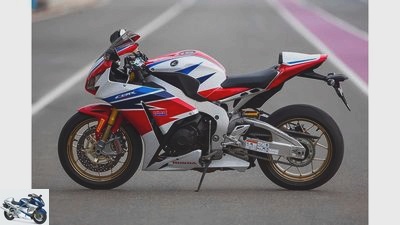
Honda
17/22
Golden wheels and HRC paint make the SP an eye-catcher.
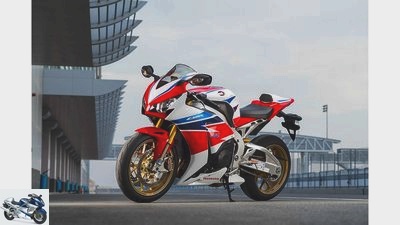
Honda
18/22
A lighter rear frame saves the single-seater SP one kilo in weight, and the significantly tighter seat cushion should provide more feedback on the popometer.
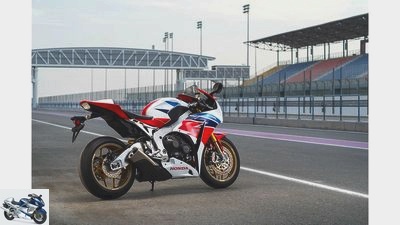
Honda
19/22
The price of the Honda Fireblade SP is not entirely without.
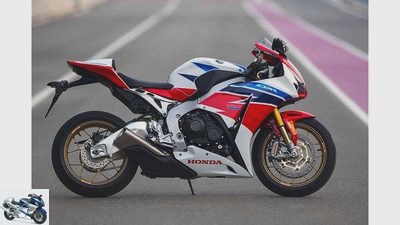
Honda
20/22
That is just under 18,300 euros.
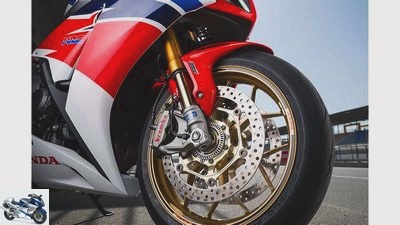
Honda
21/22
Powerful feet on the Ohlins fork for rigidity, stable monobloc pliers for a constant bite.

Honda
22/22
Whether the capabilities and equipment of the Honda CBR 1000 RR Fireblade SP are sufficient against the competition, which lures with the full arsenal of electronic driving aids, that is the exciting question that a comparison test will clarify.
Honda CBR 1000 RR Fireblade SP in the driving report
Refinement and Precision
No wild performance data, no spectacular electronic gimmicks. The Honda CBR 1000 RR Fireblade SP focuses on targeted detail work and the finest ingredients.
How one can be mistaken. Leaving the paintwork in the traditional HRC colors – that of the Honda CBR 1000 RR F.ireblade SP stand out very well – once disregarded, there is hardly anything to suggest that Honda’s top athletes for 2014 have experienced more than just optical retouching.
Buy complete article
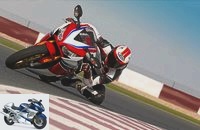
Honda CBR 1000 RR Fireblade SP in the driving report
Refinement and Precision
Fireblade to provide an SP variant that is more tailored to racing use alongside the basic model. And that brings us to another novelty at Honda: The Honda CBR 1000 RR Fireblade SP, which was available at the presentation on the Losail circuit in Doha, is the first sport bike from the Japanese that is not equipped with Showa and Nissin components but with Brembo Monobloc pliers and Ohlins spring elements.
Legs are stowed away more comfortably
But of course there are changes to the chassis and engine that share both the standard and the SP version and help the blade to achieve an increase in output of 3 to 181 hp. However, the Honda CBR 1000 RR Fireblade SP alone benefits from selected pistons which differ in weight by a maximum of one gram (standard: three grams).
Honda
Golden wheels and HRC paint make the SP an eye-catcher.
Your Ohlins fork has a standpipe diameter one millimeter larger than the Showa counterpart of the base, and is also located in a CNC-machined upper and a revised lower triple clamp, which are connected by a steel head tube with a wall thickness of just two millimeters.
The combined ABS can still not be switched off, but for the Honda CBR 1000 RR Fireblade SP it is more geared towards sports use. Stepping on the rear brake no longer activates the front brake as strongly. A lighter rear frame saves the single-seater SP one kilogram of weight, and the significantly tighter seat cushion should provide more feedback on the popometer. The SP also rolls on sporty Pirelli SP rubbers.
So it was out on the slopes in the morning. The revised sitting posture quickly proves to be a good grip, the legs are stowed more comfortably, the knee angle is not too sporty, it feels good.
The four-in-a-row marches cleanly through the speed range, and storms nicely evenly and powerfully towards its climax, which it reaches about 800 revolutions before locking. From then on, the forward urge subsides again before the limiter intervenes relatively hard. To be of real help in finding the right gear shift speed, the shift lights in the cockpit should light up brighter. Getting loud or rough is not in the nature of the Honda and its sophisticated four-cylinder. Which is partly due to the fact that the load changes are no longer so concise. Only in second gear does the first use of power seem a little harder than necessary. The Fireblade SP has also gained a touch of handiness. According to the Ohlins technicians, their spring elements are fitted with slightly softer, but more powerfully pre-tensioned springs, which raises the vehicle level overall. It’s great how the blade can be angled deeper and deeper with it. However, the smoothly ironed slopes of Qatar are not enough of a challenge to really feel the spring elements.
Slides on the rear wheel are easy to control
Nevertheless, there was movement in the rear when it was turned over quickly and accelerated hard. The attempt to remedy this with a tougher setting at the rear, however, went hand in hand with less grip on the rear wheel. At least now, a ride-by-wire with traction control would have been helpful.
Apparently, Honda does not want to simply use another system among many, but rather a solution that is one step ahead of the competition. However, it is questionable whether it is the right decision to have the Honda CBR 1000 RR Fireblade SP compete without these driving aids. At least the slides on the rear wheel can be easily controlled thanks to the great feedback and finely adjustable throttle. And finally we were still on the road with road tires. And since the Blade made its first business card on the racetrack, it was strapped on sticky racing rubbers, Pirelli Supercorsa SC II, for the afternoon. Soled like this, she could really show what she’s made of. The rear tire in the 190/55 format lifts the rear slightly in a way that is easy to handle, which gives a further boost to maneuverability. Why the series is still sticking to the old 190/50 will probably remain Honda’s secret. In spite of the somewhat dusty slope, it was there now, that crisp, direct turn-in, the precise and tight holding of the
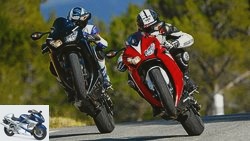
Super athlete
Honda CBR 1000 RR Fireblade in the test
Production model against Wellbrock conversion "Power edition"
read more
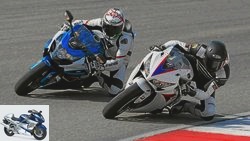
Super athlete
The last four-cylinder without control electronics
Test: Honda Fireblade against Suzuki GSX-R 1000
read more
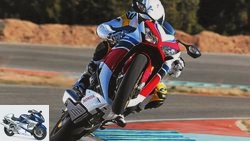
Super athlete
Honda Fireblade SP in the PS performance test
Prettified, smoothed and lifted
read more
Honda CBR 1000 RR Fireblade SP happily lifts the front wheel
Line at the exit of the curve. And the previously somewhat cautious feeling for the front wheel gave way to crystal clear transparency. The stiffer front certainly does its part. And then cock the tap precisely at the apex of the curve. The strengthened middle and the good throttle response allow the well-measured use of power. The Honda CBR 1000 RR Fireblade SP happily lifts the front wheel in second gear. Wheelies can be dosed finely with the right hand. At the end of the approximately one kilometer long home straight, the Blade rushes into the braking zone with around 285 on the speedometer. Not only does a lot of performance make you fast, but also the possibility of using your performance at an early stage. Incidentally, the new windshield offers decent wind protection.
The Honda ABS, which is a brake-by-wire system, i.e. has no direct connection from the hand lever to the hydraulics, still does not provide the same feeling as conventional brakes. But the Brembos with their 30 and 32 mm brake pistons are of the stable type. In the first grab it is quite gentle, but then quite vehemently as the hand strength increases. Some racers might have wished for a slightly stronger initial bite, but this configuration is certainly not a disadvantage on country roads. An overly aggressive set-up would not have fitted into the image of the balanced, easily manageable driving machine. In that regard, the Fireblade is arguably better than ever. Whether that is enough in view of the rather steep price of 18,290 euros against the competition, which lures with the full arsenal of electronic driving aids, that is the exciting question that a comparison test will clarify.
That is new?
Honda
It is questionable whether it was the right decision to let the Blade start without these driving aids. At least the slides on the rear wheel can be easily controlled thanks to the great feedback and finely adjustable throttle.
- channels newly formed and polished, new mapping, power increased from 131 kW / 178 hp to 133 kW / 181 hp, inclined intake trumpets.
- Thinner manifolds (35 instead of 38 mm) interference pipe between manifold two and three, exhaust internals revised, battery 6 Ah (2013: 7 Ah).
- frame more flexible in the area of the swing arm mount.
- Windshield Pulled higher for better aerodynamics.
- Handlebar stub flared five degrees further and cranked down, footrests 10 mm further back.
Additional equipment of the SP version:
- Ohlins fork with 55 mm stanchions (Showa: 54 mm), Ohlins TTX shock absorber.
- Pistons and connecting rods balanced in terms of weight.
- Brembo Monobloc brake calipers, C-ABS designed for the racetrack.
- Upper triple clamp CNC-manufactured, steel steering shaft tube (standard: aluminum).
- Mono humps, lighter rear frame.
- Tires Pirelli Supercorsa SP.
- Seat pad harder.
facts and figures
Honda
The Combined ABS can still not be switched off, but for the SP it is more geared towards sports use. Stepping on the rear brake no longer activates the front brake as strongly.
engine
Water-cooled four-cylinder four-stroke in-line engine, a balance shaft, two overhead, chain-driven camshafts, four valves per cylinder, bucket tappets, wet sump lubrication, injection, Ø 46 mm, regulated catalytic converter, 409 W alternator, 12 V / 6 Ah battery, mechanically operated multi-disc oil bath clutch (Anti-hopping), six-speed gearbox, O-ring chain 2,625.
Bore x stroke: 76.0 x 55.1 mm
Displacement: 1000 cm³
Compression ratio: 12.3: 1
Rated output: 133.0 kW (181 hp) at 12,000 rpm
Max. Torque: 114 Nm at 10,500 rpm
landing gear
Bridge frame made of aluminum, upside-down fork, Ø 43 mm, electro-hydraulic steering damper, adjustable spring base, rebound and compression damping, two-arm swing arm made of aluminum, central spring strut with lever system, adjustable spring base, rebound and compression damping, double disc brake at the front, Ø 320 mm, four-piston Fixed calipers, rear disc brake, Ø 220 mm, single-piston floating caliper, ABS.
Cast aluminum wheels: 3.50 x 17; 6.00 x 17
Tires: 120/70 ZR 17; 190/50 ZR 17
mass and weight
Wheelbase 1410 mm, steering head angle 66.7 degrees, caster 96 mm, spring travel f / r 120/135 mm, seat height 820 mm, weight with a full tank of 210 kg *, tank capacity 17.5 / 4.0 liters.
Guarantee: two years
Service intervals: 6000 km
Colors: red / white / blue
Price: 18,290 euros
Additional costs: 295 euros
Related articles
-
Driving report Honda Fireblade SP
Honda 30th photos Honda 1/30 The adjusting screws of the rear Showa shock absorber are easily accessible. Honda 2/30 The 2017 new Honda Fireblade has…
-
Honda Fireblade vs. Suzuki GSX-R 1000 in comparison test
Maccabelli The last four-cylinder without control electronics Test: Honda Fireblade against Suzuki GSX-R 1000 Contents of They are the last current …
-
Zonko’s attack on the Honda CB 1000 R
andreasriedmann.at 14 pictures andreasriedmann.at 1/14 Honda CB 1000 R. andreasriedmann.at 2/14 In the lower and middle speed range, the quad …
-
Technology 20 years of progress in motorcycle construction: Honda Fireblade – old against new
fact 14th photos fact 1/14 At the end of 1991 Honda presented the first Fireblade and shook the athlete Olympus permanently. We compare the Fireblade SC…
-
Honda CB 1000 R-Fireblade, KTM 990 Super Duke R-1190 RC8, MV Agusta Brutale 1078 RR-F4 1078 RR
K Honda CB 1000 R / Fireblade, KTM 990 Super Duke R / 1190 RC8, MV Agusta Brutale 1078 RR / F4 1078 RR Tube or stub? Content of Super athlete or naked…
-
factstudio.de 15th photos factstudio.de 1/15 Honda CB 1000 R + in the top test. factstudio.de 2/15 The design line of the new CB 1000 R is called “Neo…
-
Test BMW R 1100 S against Honda VTR 1000 F
Honda VTR 1000 F Fire Storm Comparison test, BMW R 1100 S, Honda VTR 1000 F Firestorm BMW R 1100 S versus Honda VTR 1000 F “The R 1100 S is not a super…
-
Super sports car Ducati 899 Panigale, Honda Fireblade SP Triumph Daytona 675 in the test
fact 31 photos fact 1/31 There are currently no brand new athletes. Some people therefore complain that nothing is moving anymore. Not correct! In the…
-
Test: Wunderlich BMW S 1000 RR and triple speed KTM SD8
fact Test: Wunderlich BMW S 1000 RR and triple speed KTM SD8 Naked superbikes with no mercy Content of Never ask about the point of strong naked bikes….
-
Honda Fireblade SP in the PS driving report
Honda 26 pictures Honda 1/26 Honda CBR 1000 RR Fireblade SP. Honda 2/26 New titanium rear silencer. Sounds wonderful, fits nicely into the line of …